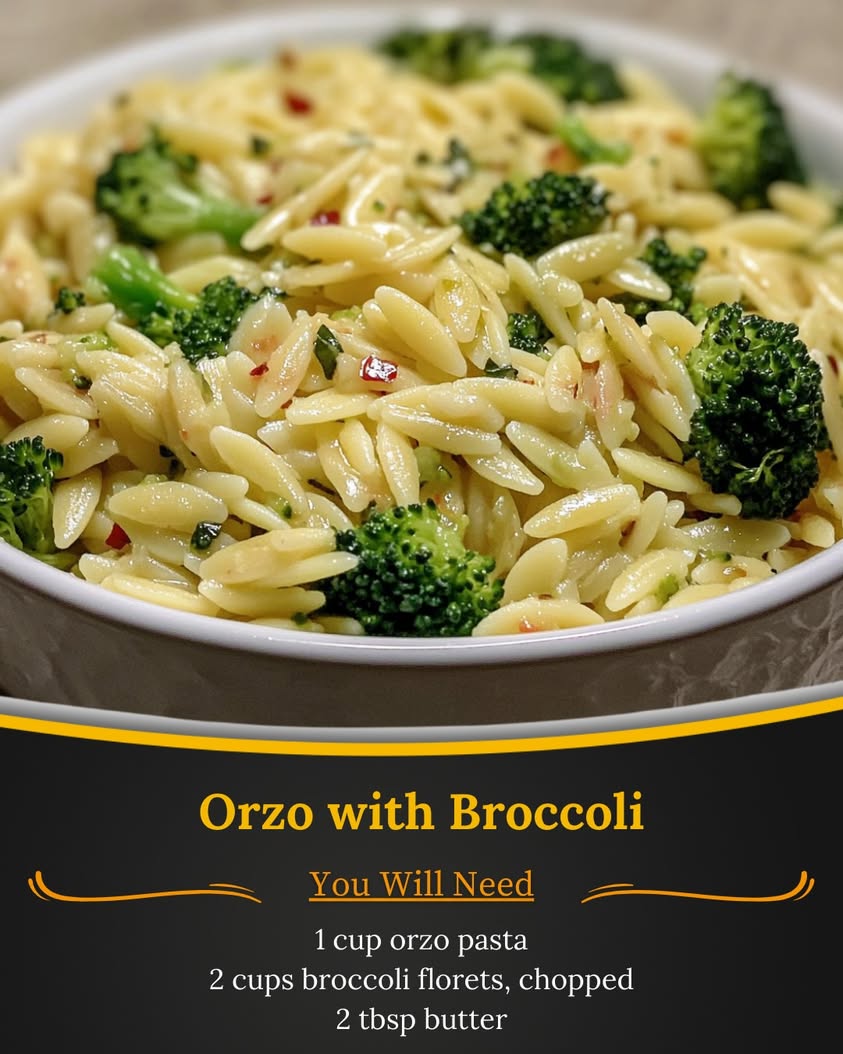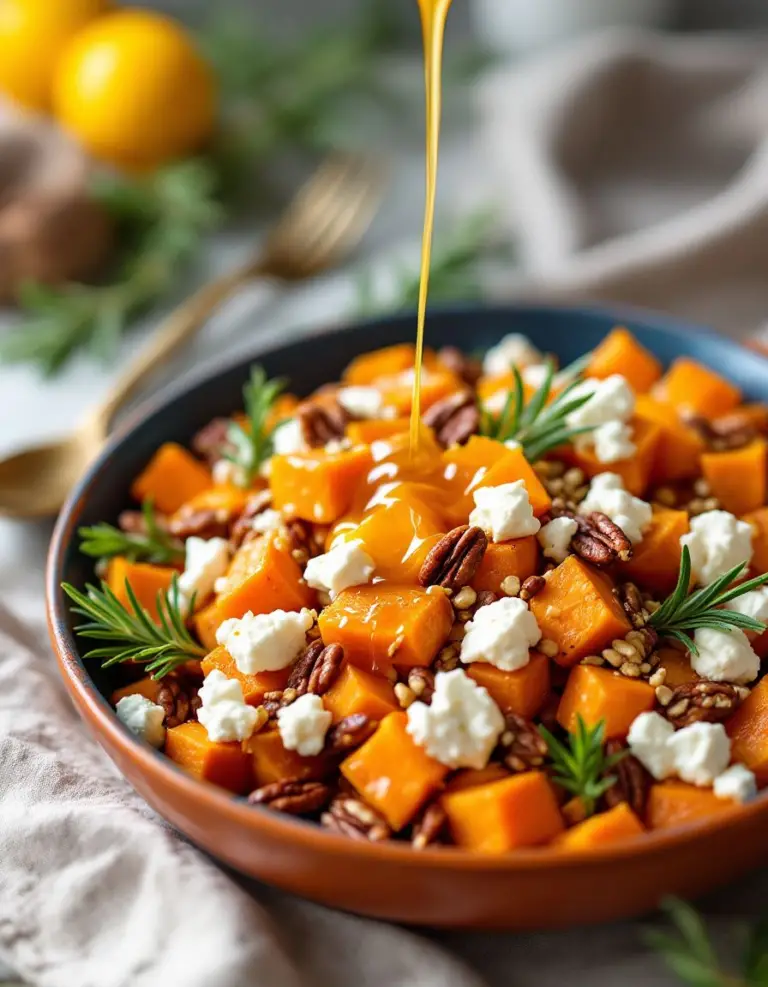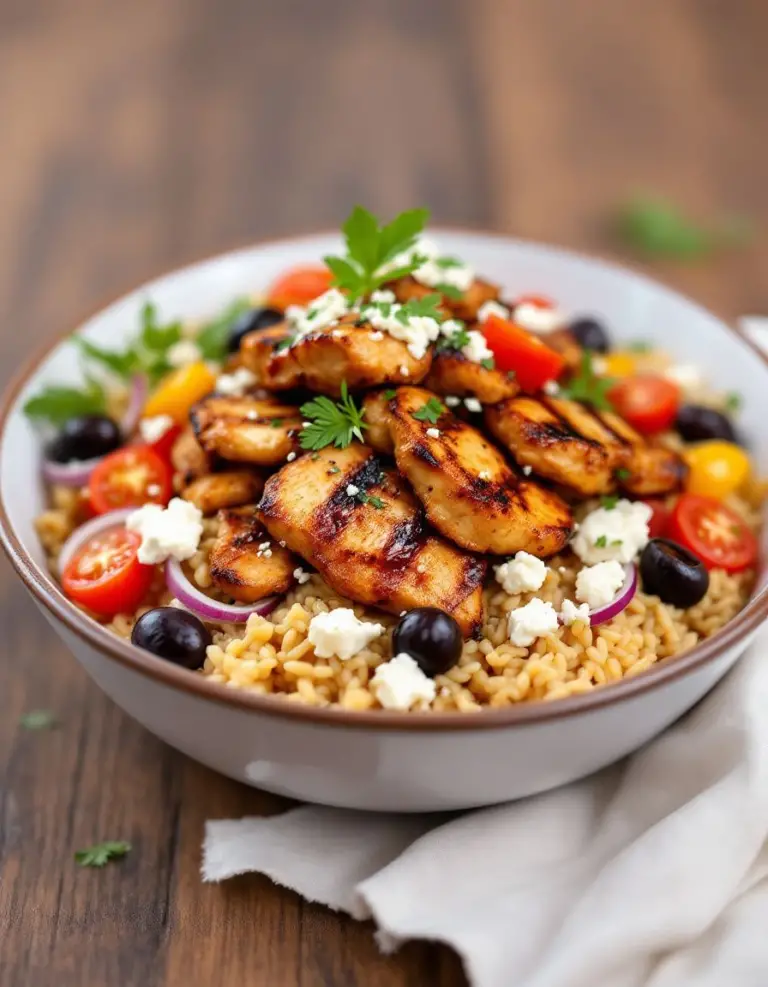Delicious Orzo with Broccoli: A Quick and Healthy Recipe

Delicious Orzo with Broccoli: A Quick and Wholesome Delight
Orzo with Broccoli is a beautifully simple dish that perfectly highlights the flavors of fresh ingredients. The combination of tender orzo pasta and vibrant broccoli creates a plate that is as visually appealing as it is delicious. Drizzled with olive oil and complemented by a sprinkle of parmesan cheese and garlic, this dish delivers a delightful experience that is comforting and satisfying. Whether you are looking for a quick weeknight dinner or a side dish for a gathering, Orzo with Broccoli fits the bill perfectly.
The sweetness of the broccoli elevates the mild nuttiness of the orzo, creating a harmonious balance that is sure to please. With its charming flavors and delightful textures, your family will be reaching for seconds. Plus, it’s a fantastic way to sneak in some veggies, making it ideal for those picky eaters. Easy to prepare and even easier to enjoy, this dish is a must-try for anyone seeking a healthy yet satisfying meal.
Quick Recipe Highlights
- Flavor Profile: A delightful blend of nutty orzo and fresh, slightly sweet broccoli, enhanced by garlic and parmesan.
- Texture: Silky orzo paired with crisp-tender broccoli offers a pleasing mouthfeel.
- Aroma: The garlic sautéing gives off a warm, inviting aroma that whets the appetite.
- Visual Appeal: Bright green broccoli against the creamy orzo beautifully contrasts and makes for a stunning presentation.
- Skill Level Needed: This recipe is suitable for all skill levels, requiring only basic cooking techniques.
- Special Equipment: A pot for boiling pasta and a skillet for sautéing ingredients.
Recipe Overview
- Difficulty Level: This recipe is categorized as easy, making it perfect for beginner cooks and busy weeknights.
- Category: Ideal as a pasta dish or as a side, this recipe brings versatility to any meal.
- Cuisine: Rooted in Mediterranean influences, this recipe celebrates the goodness of fresh produce and simple flavors.
- Cost: With affordable ingredients, this dish comes in at under $10, making it budget-friendly.
- Season: Perfect in spring and summer when broccoli is at its freshest, but it can be enjoyed year-round.
- Occasion: Great for family dinners, potlucks, or as a light lunch.
Why You’ll Love This Recipe
This Orzo with Broccoli recipe is all about exceptional taste and texture. The combination of slightly chewy orzo and vibrant broccoli creates a delightful eating experience that delights the palate. The addition of garlic enhances the overall flavor profile, making it satisfying without being overwhelming. Whether served as a main dish or a side, it’s guaranteed to satisfy.
Convenience is another reason this dish is a favorite among busy home cooks. With just a handful of pantry staples, you can whip up this delightful meal in less than thirty minutes, making it perfect for those hectic evenings when time is of the essence.
Nutritionally, Orzo with Broccoli is a win. Packed with vitamins and fiber from the broccoli, this dish supports a balanced diet. The orzo, made primarily from durum wheat, is also a source of carbohydrates that will keep you fueled throughout the day, making it an excellent choice for both dinner and lunch.
Socially, this dish holds a special value. It’s easy to multiply this recipe for larger gatherings, making it a go-to for family reunions, potlucks, and community events. As a shared dish, it sparks conversation and encourages connection around the dinner table.
Cost-effectiveness and accessibility ensure this recipe fits into anyone’s culinary repertoire. With just a few cost-friendly ingredients that are readily available at any grocery store, it’s a dish that everyone can prepare and enjoy without breaking the bank.
Historical Background and Cultural Significance
Orzo has its roots deeply embedded in Italian cuisine, where it has been a staple for centuries. Originating as a means to utilize wheat, this tiny pasta resembles rice, hence its name, which translates to “barley” in Italian. Its adaptability allowed it to flourish in various culinary traditions, including Greek and Middle Eastern cuisines.
In cultural contexts, pasta dishes like Orzo with Broccoli symbolize the heart of Italian family meals. Traditionally served during family gatherings, it expresses the importance of coming together to enjoy a nourishing meal, emphasizing love, care, and community through shared cooking.
As food and cooking continue to evolve, Orzo has received numerous adaptations influenced by health trends and dietary preferences, leading to gluten-free alternatives and whole-grain versions, keeping pace with today’s consumers’ needs.
Regional variations are prevalent, where different herbs, spices, or additional proteins are introduced to create diverse flavors. From adding lemon zest for brightness to tossing in proteins like chicken or shrimp, you’ll find that orzo’s versatility caters to diverse palates and cuisines.
Ingredient Deep Dive
Orzo: As a staple ingredient, orzo derives from traditional Italian cooking. It brings comforting flavors that pair beautifully with various ingredients. Nutritionally, it provides a good source of complex carbohydrates. When selecting orzo, consider whole grain options for added fiber. For storage, keep it in a cool, dry place. Substitutions may include quinoa or rice, depending on dietary needs.
Broccoli: This cruciferous vegetable is well-loved for its crunchy texture and nutrient density. Originating from the Mediterranean region, broccoli is celebrated for its health benefits, including high vitamin C and fiber content. When choosing broccoli, look for firm stalks and vibrant green heads. It can be stored in the refrigerator for several days. Substitutions like asparagus or green beans can be used for those who prefer different flavors.
Common Mistakes to Avoid
- Overcooking the orzo, leading to a mushy texture. Always keep an eye on the cooking process to achieve an al dente bite.
- Not salting the water can result in bland pasta; seasoning the cooking water is crucial for flavor.
- Using old broccoli, which can lose its crispness and flavor. Always opt for fresh, vibrant vegetables.
- Sautéing garlic too long can lead to bitterness. Aim for a golden hue to maintain its sweetness.
- Forgetting to reserve pasta water, which can be used to adjust sauce consistency later.
- Not measuring ingredients gets unpredictable outcomes; follow the recipe for the best results.
- Skipping the cheese can reduce flavor depth; use freshly grated parmesan for a burst of umami.
- Rushing the sauté process; allow broccoli to develop a lovely char for enhanced flavor.
- Ignoring the importance of letting the dish rest, allowing flavors to meld together for a better taste.
- Using too much liquid may make the dish soupy at the end; ensure proper measurements.
Essential Techniques
Cooking orzo requires meticulous attention to ensure fluffy and separate grains. The pasta should be cooked al dente, which allows it to absorb sauce without becoming mushy. To achieve this, follow the package instructions closely and taste for the right firmness.
Sautéing garlic is a cornerstone technique in this dish. Start in cold oil and gradually heat, which prevents the garlic from burning and allows it to infuse its flavor within the oil. Watch for visual cues, like a light golden color, to signify the garlic is perfectly cooked and ready for the next steps.
Pro Tips for Perfect Orzo with Broccoli
– Use vegetable or chicken broth instead of water for boiling orzo to infuse additional flavor.
– Add a squeeze of lemon juice before serving for a refreshing brightness that complements the dish.
– Try incorporating other vegetables like spinach or peas to up the nutritional value and add color.
– For added protein, toss in cooked chicken, chickpeas, or beans, transforming the dish into a hearty meal.
– Make it creamy by stirred in a dollop of cream cheese or ricotta.
– For a vegan version, omit the cheese or use nutritional yeast for similar flavors.
– Add crushed red pepper flakes for a spicy kick that enhances the overall profile of the dish.
– Top with toasted pine nuts for a crunchy texture that complements the tender orzo.
Variations and Adaptations
Regional variations often see the introduction of local ingredients, such as using seasonal vegetables or different herbs. In the Mediterranean regions, you might find local cheese variations or the addition of olives, which enhance the dish further.
Seasonal adaptations allow for exciting twists; for instance, in autumn, butternut squash can be roasted and added for a comforting, sweeter flavor profile that pairs beautifully with the dish’s nuttiness.
Dietary modifications, such as gluten-free orzo or substituting broccoli with kale or Swiss chard, ensure this dish meets the needs of diverse diet preferences without sacrificing flavor.
For flavor variations, consider adding sun-dried tomatoes or a pesto swirl to elevate the taste. Texture modifications can be explored by stirring in crispy prosciutto or breadcrumbs for a delightful crunch. Presentation alternatives can include serving the orzo in a hollowed-out bell pepper for a stunning visual effect.
Serving and Presentation Guide
When plating Orzo with Broccoli, consider a large, shallow bowl to give it a familial, inviting appearance. Garnish with freshly chopped parsley or basil for a pop of color and freshness that contrasts the dish’s warmth.
Garnishing with a sprinkle of parmesan or a drizzle of high-quality olive oil adds an elegant finishing touch. For traditional accompaniments, serve with crusty artisan bread or a light salad, enhancing the dining experience.
Consider serving it warm or at room temperature, allowing the flavors to shine while ensuring it remains comforting. For portion control, use a measuring cup or a ladle to ensure equal servings, which also aids in visually pleasing presentations.
Wine and Beverage Pairing
For wine pairings, a crisp Sauvignon Blanc or a light Pinot Grigio beautifully complements the bright flavors of broccoli while balancing the richness of the dish. If you prefer red, a light-bodied Grenache would also serve well.
Non-alcoholic alternatives, such as sparkling water with a twist of lemon or iced herbal tea, can refresh the palate without overshadowing the meal.
Consider pairing with herbal teas that have mild flavors, allowing them to enhance rather than compete with the dish. Serve beverages chilled to match the fresh vibe of the Orzo with Broccoli.
Storage and Shelf Life
When storing leftovers, place Orzo with Broccoli in an airtight container in the refrigerator. It should last for 3 to 5 days, retaining its delightful flavors. To avoid spoilage, always ensure stored meals are kept below 40°F.
For reheating, place the pasta in a saucepan over low heat, adding a splash of water or oil to bring moisture back into the dish. Ensure it is thoroughly heated before serving. Alternatively, this meal freezes well, lasting up to 3 months in the freezer. For best results, store in individual portions.
Signs of spoilage include off-smelling aromas or a change in texture; always inspect meals before consumption to ensure freshness.
Make Ahead Strategies
Preparing Orzo with Broccoli can be efficient with some make-ahead strategies. Cook the orzo and broccoli separately, storing each component in the refrigerator until ready to assemble just before serving. This maintains texture and flavor integrity.
For quality retention, consider preparing the garlic oil ahead of time. Storing it in a sealed jar in the fridge allows for quick flavor infusion during final cooking steps.
When reheating, other elements, such as cheese, can be added fresh to maintain its creamy texture. Fresh herbs can also be chopped and stored for garnishing right before serving for a bright finish.
Scaling Instructions
Scaling this Orzo with Broccoli recipe is straightforward. Halving the recipe is perfect for those cooking for one or two, ensuring that the cooking times remain the same while proportionate.
When doubling or tripling the recipe, ensure to use a larger pot to accommodate the increased volume. Keep in mind that the cooking times might require slight adjustments; always taste test to ensure perfect doneness.
Equipment adjustments can be made, like using a larger skillet or multiple cooking pots, particularly when cooking for larger families or gatherings, ensuring every guest receives a satisfying portion.
Nutritional Deep Dive
Delving into the nutritional aspects of Orzo with Broccoli reveals a balanced macro profile. The orzo primarily contributes carbohydrates, while broccoli complements with dietary fiber and vitamins A and C, making for a nutritious meal.
Micronutrient analysis highlights the addition of calcium and antioxidants from the garlic and cheese used, which supports overall health. Coupled with the fiber content from broccoli, this dish promotes digestive health.
Health benefits extend further, with ingredients like broccoli demonstrating cancer-fighting properties and orzo offering sustained energy. It’s a health-conscious choice that doesn’t skimp on taste, perfect for weight management.
For effective portion analysis, a serving size of about one cup contains around 300-400 calories, making it an ideal choice for those watching caloric intake while desiring flavorful meals.
Dietary Adaptations
This recipe can easily cater to various dietary preferences. For those on gluten-free diets, substitute the orzo with rice or gluten-free pasta alternatives, ensuring no flavor is lost while adhering to dietary needs.
A dairy-free version can be achieved by omitting cheese or using nutritional yeast for a cheesy flavor without the lactose. Similarly, vegetable broth can replace chicken broth for a vegan-friendly approach.
Low-carb dieters might opt for zucchini noodles instead of orzo to maintain a similar texture while significantly reducing carb intake. Paleo followers can replace orzo with cauliflower rice, complementing the dish’s freshness with a new layer of nutrients.
Bringing these modifications into play ensures that Orzo with Broccoli remains inclusive and delicious for everyone attending the table.
Troubleshooting Guide
Should your orzo become too gummy, it’s often a result of overcooking. Adjust your technique by keeping a close watch on the boiling process and tasting frequently to ensure you achieve that desired al dente texture.
In cases where flavors seem unbalanced, consider adjusting saltiness by incorporating more cheese or freshly cracked pepper. If bitterness arises from burnt garlic, it’s critical to keep garlic cooking time to a minimum to preserve its sweetness.
Temperature problems can be solved by adjusting cooking heat more fluidly — if ingredients cook too quickly, reduce heat and allow for even cooking. Additionally, ensure all ingredients are prepped to the right size and uniform to promote even cooking.
For ingredient substitutions that may not taste as intended, it showcases the dish’s flexibility but may require more adjustments in seasoning or approach, notably mixing other herbs or spices to blend flavors seamlessly.
Timely concerns can often lead to rushed results. Always plan adequately for prep and cooking times to maintain the integrity of the dish and achieve an optimal flavor profile.
Recipe Success Stories
Your experience with Orzo with Broccoli may include numerous spontaneous variations, capturing unique flavors within your community. Many home cooks have embraced its adaptability with local vegetables, receiving rave reviews from friends and family.
A community partner embraced the recipe by introducing any seasonal vegetables, discussing how happy diners can create their versions while retaining the core harmony of flavors.
Some pots have featured vibrant photos shared by readers showcasing their beautifully plated dishes, each adding their person touches through garnishes or substitutions, demonstrating the dish’s versatility.
Creative adaptations from readers include vegan-friendly versions or exciting flavor profiles that can inspire further culinary exploration with pasta dishes.
Photography tips from those who shared their meals online suggest natural light enhances the visual appeal of this dish, highlighting the colorful ingredients, always encouraging sharing and showing off culinary triumphs.
Frequently Asked Questions
Can I use frozen broccoli in this recipe?
Yes, frozen broccoli can be used. Just ensure to thaw and drain any excess water to avoid a watery dish.
What other vegetables can I add?
Feel free to add vegetables like bell peppers, spinach, or peas. They pair well with orzo and elevate the nutritional content.
Can this dish be served cold?
Absolutely! Orzo with Broccoli makes a great pasta salad when served chilled, perfect for summer picnics.
How do I store leftovers?
Store any leftovers in an airtight container in the fridge for up to 5 days. Make sure to reheat gently to maintain texture.
Can I make this ahead of time?
Yes! You can cook orzo and broccoli separately ahead of time. Just combine them right before serving.
What’s the best way to reheat orzo?
Reheat on the stove over low heat, adding a splash of water or oil to restore moisture.
Can I use gluten-free orzo?
Yes, gluten-free orzo is an excellent substitute for this recipe while keeping the same method and flavor intact.
What can I serve as a side dish?
Pair it with a light salad or garlic bread for a delightful complete meal.
How can I make it spicier?
Add crushed red pepper flakes or diced jalapeños to give it an exciting kick!
What cheese should I use?
Freshly grated parmesan is recommended, but feel free to try pecorino or a dairy-free cheese to suit your preferences.
Additional Resources
If you’re interested in more pasta dishes, check out our collection of delicious recipes featuring various pasta types. Expand your culinary skills by exploring technique guides that cover everything from perfecting sauce creation to mastering basic pasta cooking.
For more information on ingredients you might use, including tips on selecting and storing fresh produce, check our in-depth guides. We also provide equipment recommendations to aid in your kitchen adventures, ensuring you have the right tools to get started.
Don’t forget to explore seasonal variations to keep your cooking fresh and exciting throughout the year!
Join the Conversation
We invite you to share your experiences with Orzo with Broccoli on our social media pages. Your photography inspires our community, so be sure to post your creations and tag us!
We love hearing recipe reviews, adaptations, and clever variations. Let’s engage and share our culinary journeys, celebrating every bite along the way!
The Recipe
Orzo with Broccoli
Serves: 4 servings
Prep Time: 10 mins
Cook Time: 20 mins
Total Time: 30 mins
Kitchen Equipment Needed
- Large pot
- Skillet
- Colander
- Measuring spoons
- Serving utensils
Ingredients
- 1 cup orzo
- 2 cups broccoli florets
- 2 tablespoons olive oil
- 2 cloves garlic, minced
- 1/2 cup grated parmesan cheese
- Salt and pepper to taste
- Optional: Red pepper flakes for heat
Directions
- Boil a large pot of salted water. Cook the orzo according to package instructions until al dente, about 8-10 minutes.
- Add the broccoli florets to the pot in the last 2 minutes of cooking. Drain and set aside.
- In a skillet, heat olive oil over medium heat. Add minced garlic and sauté until fragrant, about 1 minute.
- Toss the drained orzo and broccoli into the skillet with the garlic. Stir to combine and heat through.
- Remove from heat and stir in grated parmesan cheese. Season with salt and pepper to taste. Serve warm.
Recipe Notes
- For a lighter option, substitute olive oil with a non-stick alternative or sauté with vegetable broth.
- Customize your cheese by incorporating feta or a blend of your favorites for a twist.
- Try adding in some cherry tomatoes for an extra layer of flavor and color.






